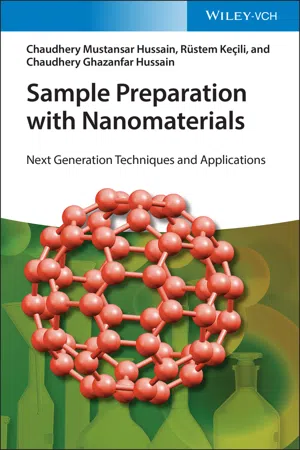
Sample Preparation with Nanomaterials
Next Generation Techniques and Applications
- English
- ePUB (mobile friendly)
- Available on iOS & Android
Sample Preparation with Nanomaterials
Next Generation Techniques and Applications
About This Book
Discover this timely, comprehensive, and up-to-date exploration ofcrucial aspectsof the use of nanomaterials in analytical chemistry
Sample Preparation with Nanomaterials: Next Generation Techniques for Sample Preparation deliversinsightful and complete overview of recent progress in the use of nanomaterials in sample preparation. The book begins with an overview of special features of nanomaterials and their applications in analytical sciences. Important types of nanomaterials, like carbon nanotubes and magnetic particles, are reviewed and biological sample preparation and lab-on-a-chip systems are presented.
The distinguished author places special emphasis on approaches that tend to green and reduce the cost of sample treatment processes. He also discusses the legal, economical, and toxicity aspects of nanomaterial samples. This book includes extensive reference material, like a complete list of manufacturers, that makes it invaluable for professionals in analytical chemistry.
Sample Preparation withNanomaterials offersconsiderations of the economic aspects of nanomaterials, as well as the assessment of their toxicity and risk.Readerswill also benefit from the inclusion of:
- A thorough introduction to nanomaterials in the analytical sciences and special properties of nanomaterials for sample preparation
- An exploration of the mechanism of adsorption and desorption on nanomaterials, including carbon nanomaterials used as adsorbents
- Discussions of membrane applications of nanomaterials, surface enhanced raman spectroscopy, and the use ofnanomaterials for biological sample preparation
- A treatment of magnetic nanomaterials, lab-on-a-chip nanomaterials, and toxicity andrisk assessment of nanomaterials
Perfect for analytical chemists, materials scientists, and process engineers, Sample Preparation with Nanomaterials: Next Generation Techniques for Sample Preparation will also earn a place in the libraries of analytical laboratories, universities, and companies who conduct research into nanomaterials and seek a one-stop resource for sample preparation.
Frequently asked questions
Information
1
Nanomaterials (NMs) in Analytical Sciences
1.1 Introduction
1.2 Types of NMs
1.2.1 Graphene
Table of contents
- Cover
- Table of Contents
- Title Page
- Copyright
- 1 Nanomaterials (NMs) in Analytical Sciences
- 2 Special Properties of Nanomaterials (NMs) for Sample Preparation
- 3 Adsorption Mechanism on Nanomaterials (NMs)
- 4 Carbon Nanomaterials (CNMs) as Adsorbents for Sample Preparation
- 5 Membrane Applications of Nanomaterials (NMs)
- 6 Surface-Enhanced Raman Spectroscopy (SERS) with Nanomaterials (NMs)
- 7 Nanomaterials (NMs) for Biological Sample Preparations
- 8 Magnetic Nanomaterials for Sample Preparation
- 9 Lab-on-a-Chip with Nanomaterials (NMs)
- 10 Toxicity and Risk Assessment of Nanomaterials
- 11 Economic Aspects of Nanomaterials (NMs) for Sample Preparation
- 12 Legal Aspects of Nanomaterials (NMs) for Sample Preparation
- 13 Monitoring of Nanomaterials (NMs) in the Environment
- 14 Future Prospect of Sampling
- Index
- End User License Agreement